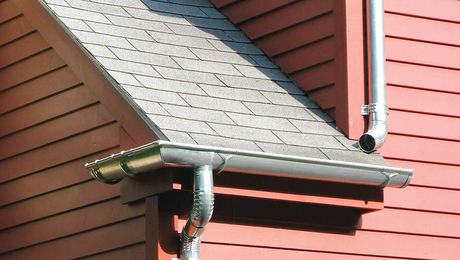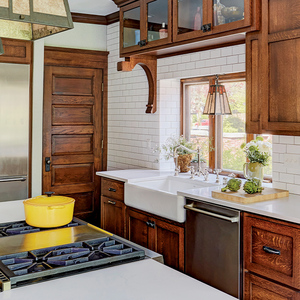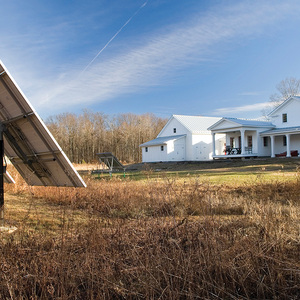toescrewing 2×4’s between basement joist
Dear all:
I’m installing some rigid foam between each joist in my basement in a cantilevered area that extends out from my basement foundation wall (see picture of proposed placement of rigid from from an editor here, Justin).
One of the 2×4’s that spans a pair of joists is missing (there was an old exhaust vent run out between these pair of joists that was removed); and another 2×4 is badly cracked). The 2×4’s span the joists and sit on top of the wooden sill plate. Since I want to glue my sections of rigid foam board to the vertical sides of the 2×4’s I want to be sure they are all there. Is it acceptable to toescrew rather than toenail the new 2×4’s into the joists? The existing 2×4’s are all toenailed on the vertical face to the 2×6 joists (see picture). Would two screws on each end of the 2×4 be sufficient and is it OK to install the screws from the same side of the 2×4 or should some screws also be placed from the backsides of the 2×4’s (since I can access the backside from outside the home – I have the plywood soffit panel removed). I’m probably overthinking this but just thought I would run this by the experts. Thank you.
Edited 3/5/2009 8:15 pm ET by Will92





















Replies
First of all, I'd make sure the entire cantilevered space is sealed up real well to minimize drafts. (from the bottom and exterior)
Then I would pack the cantilever with high density insulation.
You dont need to draft stop the joist end at the cantilever if you have everything else sealed up well as that will not do anything for you if you have draft stopped the exterior properly.
I know that does not answer your question so to answer your question, sure you can toe screw Fastened is fastened.
Resized your pictures
Nothing wrong with toescrewing. Often screws work out better in tight spots, especially if you don't have a power nailer. Deck screws are preferred over drywall screws, though in this application it's not critical.
Screws fine for this.
for future reference, save as jpg instead of btmp immages and that will reduce file size considerably without loss of information
Then cchek your file size before posting. Anyone with dial-up connecction can't even think of openning those. make them less than 200KB to make them viewable to all.
Welcome to the
Taunton University of Knowledge FHB Campus at Breaktime.
where ...
Excellence is its own reward!
when you screw you must be careful how you do it..
simply running a screw into a piece of wood can and often does make a weak joint..
you must predrill a pilot hole large enough so the screw threads will not catch on the piece being connected in order to ensure a solid connection..
To make it simple, the top piece where the screw comes through must have a hole large enough for the screw to slide in so that the treads only bite on the bottom piece and not on both pieces..
Edited 3/6/2009 9:00 am ET by frenchy
Aw common man, he isn't talking fine hardwood - he's slapping in a few pieces of blocking is all. If you have to predrill for that, you must be long on time and short of something to do to stay out of your wive's hair
Welcome to the Taunton University of Knowledge FHB Campus at Breaktime. where ... Excellence is its own reward!
Agreed. Sometimes you have to back the screw out a bit and run it in again, if it pushes away a bit, but rarely do you need to predrill.
The modern conservative is engaged in one of man's oldest exercises in moral philosophy; that is, the search for a superior moral justification for selfishness. -John Kenneth Galbraith
He should be happy the poster was told to screw it together!>G<
Piffin my man:
If you fail to understand the need for predrilling I can understand why you have so little faith in screws..
Let's look at sheetrock screws shall we?
When you run a sheetrock screw into gypsum what happpens is the gypsum "shatters" around the screw thread and that allows the the head of the screw to pull up the sheetrock tight to the stud..
If we screw through wood first the threads of the screw gain ahold of the wood and if there is any space or gap the first piece of wood can stand off from the second piece.. that makes it impossible for the screw to pull things together..
If you predrill the threads of the screw can't lock into the first piece of wood and that means the screw will actually pull the two pieces together rather than allow a stand off..
None of that means a thing if you use the right screw for the job. I have no problem whatsoever with using screws and do it a lot. It is when the wrong screw is used that you have problems. Almost all structural screws on the market today are self drilling and DO NOT cause the problems you seem to have.
Welcome to the Taunton University of Knowledge FHB Campus at Breaktime. where ... Excellence is its own reward!
Yep. This DIY gots no nail gun and uses "construction screws" quite often. They are 3" long but only have 1.5" of threads.
Fast, easy, good in a tight spot.
Not cheap as drywall screws, but less $ than coated deck screws.
Edited 3/9/2009 12:34 pm ET by Righty_Tighty
Piffin.
I don't think you really understand.. it's not about drilling a hole. It's about preventing the screws threads from hanging up on the piece of board you are trying to attach to the board you wish to attach it to.
Whatever spacing exists between the board you are attaching and the board you are trying to screw into will remain unless the screw threads are free to slide in the piece being attached..
IF the threads are free to slide then the attached board will tighten up.. If not the spacing will remain..
Now if the screws in use have the proper shank length so only threads going into the attached board then the matter is moot.
This is very basic stuff. I hope it's only a matter of explaining it properly and not a false assumption on your part.. I don't imagine you could work this long with such a basic error..
You are the one who fails to understand,First - it is all about using the right screw. everything you are trying to elaborate is included in that. If you use the right screw, you don't need to predrill to suck the wood together. With the screws I use, predrilling gains you nothing.Second - this job is framing, not fine cabinetry.
Welcome to the Taunton University of Knowledge FHB Campus at Breaktime. where ... Excellence is its own reward!
OK then please do this little test for me..
Take two 2x4's and screw them together. Slide a 1/2 thick piece of foam between them. One test you will simply run in a screw long enough to join them together. The other test will be the same except you will predrill through the first 2x4. Go ahead and slide the same 1/2 piece of foam between those..
Use deck screws..
Now tell me which test holds or squeezes the foam tighter?
Like I said - use the right screw for the job.Why do I want to use your deck screws to hold two 2x4s together when I have good 3" x #10 GRK structrual screws?For doing it either way, I would not be able to slide a piece of foam between them. They would be so tight together I couldn't get a dollar bill to slide in. What does 1/2" foam have to do with fitting wood tight?Do you play baseball with hockeysticks too?
Use the right thing for the job! Use foam for insulation.
Welcome to the Taunton University of Knowledge FHB Campus at Breaktime. where ... Excellence is its own reward!
Cross thread bridging.. that's the term I was looking for.. It's what happens when a screw is run into two pieces of wood.. It make it impossible for the wood to ever draw tighter to gether than whatever gapping may exist when the screw threads start into the second piece of wood..
Thanks Dave!
Edited 3/9/2009 11:06 pm ET by frenchy
Well, if you avoid Piffin Screws, and pick up an appropriate screw having a long enough shank, you avoid cross thread bridging, since the part of the screw that's in the top piece has no threads.
Mike HennessyPittsburgh, PA
How 'bout that! Four of us now have the idea of using the right screw for the job!Think frenchy might catch on?
Welcome to the Taunton University of Knowledge FHB Campus at Breaktime. where ... Excellence is its own reward!
I think he already has -- he's just being a Politician, and letting ideology get in the way of the facts. ;-)
Mike HennessyPittsburgh, PA
Piffin,
I predrill everything, when hanging DW, predrill, framing nails, predrill, finish nails, predrill, hell I even predrill my predrill holes, When I'm all done pre drilling I go home & pick the fly #### out of the pepper shaker.
I think we all know when predrilling is really necessary and when to get the job done & get on with life. I can see maybe predrilling the OP project for the perpose of maybe holding the screws in place if your working close quarters, other than that, pretty much a waste of time.
Paul No one should regard themselve as "God's gift to man." But rather a mere man whos gifts are from God.
Yeah, I've predrilled when toe-screwing, when handling an especially difficult situation, especially when a high degree of precision is required. But for installing blocking?? Just hack away at it! There is a time and a place for everything.
The modern conservative is engaged in one of man's oldest exercises in moral philosophy; that is, the search for a superior moral justification for selfishness. -John Kenneth Galbraith
LMAO! Thanks
Welcome to the Taunton University of Knowledge FHB Campus at Breaktime. where ... Excellence is its own reward!
but did you predrill before the LMAO?
Frenchy - You Da Man on shellac, & forklifts, but why waste your breath arguing piffin screws with...PIFFIN?
He's just having phun role playing the Screwy Professor today
Welcome to the Taunton University of Knowledge FHB Campus at Breaktime. where ... Excellence is its own reward!
How are you doing, Lymewise, etc? (Hijack Alert!)
much better.
Got firm diagnosis from rheumatologist of post-lyme fibro and new medication. Cymbalta. Really has done me good. I can work an 8 hour day now and don't generally have the whole body pain, just a bunch of isolated individual pains I can deal with. This knuckle, that vertebrae, a sprained shoulder, etc.Rarely use any other pain med like Alleve or Vicoin anymore
Welcome to the Taunton University of Knowledge FHB Campus at Breaktime. where ... Excellence is its own reward!
I'm so glad!
It just dawned on me the other day - my neck & shoulders will most likely never be any better than they are right now - so I went immediately to my rowing machine, & have been exercising faithfully for several weeks now - guess I'm reformed!
I'll mention Cymbalta to my sister, who has fibro -
Keep up the good work!
it doesn't work for everyone. Body chemistry is strange. It is also indicated for the tingling/burning nueralgia that diabetes patients get from bad nerve connections in their extremities. Also for some patients of depression where serotonin is the culprit. I think they classify it as a serotonin re-uptake inhibitor. Nerve synapsis that are overactive for some reason get 'calmed down' so they don't transmit the pain signals as much anymore.
Welcome to the Taunton University of Knowledge FHB Campus at Breaktime. where ... Excellence is its own reward!
and I'm more mentally alert, lost some excess weight too.
Welcome to the Taunton University of Knowledge FHB Campus at Breaktime. where ... Excellence is its own reward!
Yeah, something about being in pain can really make you gain weight. It's odd, but true.
The modern conservative is engaged in one of man's oldest exercises in moral philosophy; that is, the search for a superior moral justification for selfishness. -John Kenneth Galbraith
Tends to make you less active to live in constant pain.
Welcome to the Taunton University of Knowledge FHB Campus at Breaktime. where ... Excellence is its own reward!
Cross thread bridging. I often predrill,, and will not be swayed otherwise in certain situations. Somtimes it helps to have a hole to put the screw in,, like in akward situations. I was trained by cabinet makers,, and this practice prevailed into framing. I get a hard time,, but it doesn't take THAT much longer if you have two drills,, or cut and drill on the bench,, then slap it into place.
I now use my palm nailer,, btw. What a great device for tight spots!
dave
Thank you.. that's exactly what I was trying to convey to Piffin.
Cross thread bridging.. I'd forgotten the term but not the consquences.
I too use my palm nailer when nailing in tight spots is called for When I need to screw into tight spots there are lot of automotive air tools that work beautifully..
This thread is about some simple blocking, not cross thread bridging.and I hate framing a house with a trim carpenter. He always slows things down trying for that 1/64th of an inch or better accuracy. A pro does what is right for the job at hand. Save the trim techniques for trim work, fer cryin out loud
Welcome to the Taunton University of Knowledge FHB Campus at Breaktime. where ... Excellence is its own reward!
piffin
I'm a reno guy. the drill bit would be at home. This is a cramped situation no? Somtimes crawing into a cavity with a drilled ready to go hunk of wood makes life simpler. Sometimes guys crate a circular saw up three flights of stairs to do one cut,, or a compressor into a trim job to trim one door.
to each his own. Aslong as we're all doing good work.
have you ever used a GRK screw?
Welcome to the Taunton University of Knowledge FHB Campus at Breaktime. where ... Excellence is its own reward!
From the GRK Web site:
GRK Fasteners - Contractor Locator Search Results
View Image
Your Parameters:
Country
all
State / Province
all
City
Area Code
all
ZipCode
Company
piffin
Results of Your Search
At 2009/03/12 17:05: No results found...
I guess you don't really exist!!! BIG <G>
It's about structural strength.. If you don't get upset when you see something held off the plate by toenails done improperly then you and I clearly have a differant standard to use in framing.
I don't sweat small differances but I do want full connection at all times..
Read the thread again. The guy is putting in draft stops. Nothing structural about it.my screws pull wood tight together just fine without predrilling.And if you can't cut blocking to fit tight in the first place, you shouldn't be doing carpentry. There is NO NEED for a screw to pull it tight.
Welcome to the Taunton University of Knowledge FHB Campus at Breaktime. where ... Excellence is its own reward!
gaps in framing mean cold spaces! Just buggin now! Not serious! Sorry Piffin!
GRK screws - Really!
Welcome to the Taunton University of Knowledge FHB Campus at Breaktime. where ... Excellence is its own reward!
I carry many sizes of # 8 robinson. I buy them in various deck screw colours to help them be diferentiated. What's all this GFK stuff. give a link. I buy in small boxes usually. Robinson is easy finds up here,,,, we invented them after all! Phillips get thrown out when doing installs.
wxtreemly strong, self drilling, cutting threads, and cutter under bugle heads for self countersinking in all but the hardest woods. Tork heads even less cam out than your Robbies. http://www.grkfasteners.com/and also made in Canadia BTW! German engineering.I think frenchy is still using the lag screws I sometimes find that were installed by hand back in the fifties.
Welcome to the Taunton University of Knowledge FHB Campus at Breaktime. where ... Excellence is its own reward!
I have usedboxes upon boxes of what you call GRK screws. I've used them where called for. However I aways predrill the first piece of wood.
Yes I use lag screws and deck screws and a whole variety of screws because no one screw is suitable for all applications.
However it is structurally superior to predrill even when there is self cutting threads. The reason for that is debris removal. Self cutting threads do not extract the sawdust, debris from the hole merely move it aside thus causing damage over what predrilling does.. While the screw may be in, it is not as solid as it could be because the fibers are crushed making way for both the screw and the debris. It's sort of like screwing into fiberboard..
Piffin If you take short cuts that's OK..
However if you predrilled the proper sized pilot hole, the proper sized shank hole and a countersink for the head you will find a much superior connection with far higher strength over just raming something in..
I understand with your priorities why you canot do a proper job of it.. However you shouldn't denigrate those who do it right..
I once did an experiment with a GRK: Drove one (2.5 or 3") into the narrow edge of a piece of a 2x4, using a long bit. The screw went in until the threaded part of the screw was completely exposed on the far side.
The modern conservative is engaged in one of man's oldest exercises in moral philosophy; that is, the search for a superior moral justification for selfishness. -John Kenneth Galbraith
bump
I screwed some framing together a while back and used the Jackrabit system.
It made the toe screwing much easier and better imo.
They don't slip or break.
http://www.jackrabbittool.com/
Hello everyone:
Wow! I didn't expect this much discussion on this topic but certainly appreciate everyone's input. In fact, I was suprised by all the responses since I have my e-mail set up to alert to any messages and I have had none, so thought there were no responses till I learned otherwise tonight.
First of all I wanted to clarify that while installing rigid foam blocking was my original project, during the course of installing the foam blocking I discovered several sections of 2x4's (sitting on top of the wood sill) that were either missing, or in poor shape. (I know the picture isn't that great, but if you look closely, you will see the horizontal 2x4 in that one cavity I photographed.) So, I decided to replace them before installing my foam blocking in those particular cavities. The 2x4's that were intact and in good shape had been toenailed into the adjoining joists. Once I finish replacing the missing 2x4's, I will finish putting in my squares of rigid foam block that I'm placing from outside the house (under the cantilevered area) by gluing them to the backsides of the 2x4's. I hope that makes sense to everyone.
I have a box of Western States screws from Home Depot. They are labeled Trim HD square drive DWS (not sure what the DWS means) and are 3" long #8. The box also says T-17 SS and I think the SS is for stainless steel since they certainly look like stainless. I just measured the shaft (with no threads) and it measures 1 1/8" long (not quite as long as the depth of a 2x4). The screws have what I think is called a bugle head.
I understand what Piffin has said about screws that might not require pre-drilling, but given the fact I don't mind taking my time with this job, is there anything wrong with French's approach? It may not be necessary according to some here, but is there any real harm in doing so?? What I would do is set the 2x4 between the joists, predrill the first hole through both the 2x4 and the joist, and then to drill the larger hole through just the 2x4 - just large enough so the screw will nearly slide through the 2x4. I don't think I would need to pre-drill a countersink hole since the 2x4 pine is pretty soft so I think it would snug right down by itself into the wood.
By the way, what is the real purpose of these bridging 2x4's? Do they provide structural support to the floor joists? I tried to cut the 2x4's as close as possible to the distance between the gaps but because some of the joists had twisted a bit, I found I had to put a slight angle with my miter saw on the ends of the 2x4 to make them fit better. There is still a very small gap at the ends - but not much.
No, there isn't any thing at all wrong with predrilling as long as you don't use too large of a bit. It's just a waste of time in most instances.BTW, you called the joists 2x6 but they are 2x8 or 2x10The blocking is normally the same height as the joists. Reasons for it can vary. In a cantilever location like that, it is normally just for draft stop. But since the existing were only 2x4, I suspect they were just a spacer to help somebody toenail the joists on the line.When placed in the center of the floor system, blocking has a structural function in that it helps keep the joist from rolling, so the congregate system supports more and bounces less.
Welcome to the Taunton University of Knowledge FHB Campus at Breaktime. where ... Excellence is its own reward!
The only problem with predrilling is that if you really have trim screws they have a small head and the screws risk pulling through if you use too large of a pilot hole.Otherwise, as I said earlier (and others have said), sometimes predrilling helps out in tight situations (and I suspect you have some tight situations with your blocking). Predrilling shouldn't be necessary for installing blocking in the general case, though, and the drilling regime you propose is really overkill. In particular, if you predrill the second piece you risk weakening the pullout strength of the connection (though pullout strength is not a big deal for blocking -- you could use pegs if you wanted).The main purpose of the blocking is to keep joists from twisting -- especially important when installed at the cantilever point of an overhang. It also helps transfer load between adjacent joists (when installed mid-span).Normally one would attempt to cut blocking at a length so that it needs to be lightly hammered into place, and so that it corrects any major twisting of the joists. However, when installing in a finished building overdoing that could lead to some minor drywall cracks, etc.
The modern conservative is engaged in one of man's oldest exercises in moral philosophy; that is, the search for a superior moral justification for selfishness. -John Kenneth Galbraith
Alright, I've stayed out of this long enough.
Full Disclosure: I am a nt for using screws for EVERYTHING - well, except asphalt shingles I guess.
The problem you get into with toescrewing framing is with the construction of the screws themselves. Bugle headed and flat headed screws are designed to sink into the wood so the top will sit flush when fully driven. Unfortunatly, toescrewing by it's nature requires you to be working close to th end of the grain. When you sink that head in, it acts like a wedge. You frequently get split wood, even with predrilling.
There are two methods I use to avoid this.
1. Make Pocket Holes: Use washer/pan/truss/pocket head screws (they have a flat bottom, not a wedge shape), and predrill using a pocket hole bit for #8 screws (I think that's too small a size screw) or a 1/2" spade bit for #9 or #10 screws. You start the bit into the wood at 90 degrees, then gently lay the bit into the angle you want to drive the screw. Now, even if the wood splits a little the shoulders of the screw still have a flat surface to bear onto.
2. Screw in from the opposite side: No one ever said the fastener had to be driven into the toe fastened piece first! After you get your pieces roughly placed, you can predrill a short guidence hole on the opposite side of the previous joist, about 1/2" away from the corner with previous piece of blocking at a 45 degree angle. Now you can sink your conventional screws normally. The point will go through the end grain. Although it looks little funny, you actually don't need to sink the head fully into the wood. The angle and the threads will keep the piece secure.
Tu stultus esRebuilding my home in Cypress, CAAlso a CRX fanatic!
Look, just send me to my drawer. This whole talking-to-you thing is like double punishment.
Paul,
Could plastic washers with short decking screws be used in applying roofing shingles?
No, you should use GRK cabinet screws.
The modern conservative is engaged in one of man's oldest exercises in moral philosophy; that is, the search for a superior moral justification for selfishness. -John Kenneth Galbraith
And then let's see the guy with the Telehandler strip THAT roof!
The modern conservative is engaged in one of man's oldest exercises in moral philosophy; that is, the search for a superior moral justification for selfishness. -John Kenneth Galbraith
You are a total instagator, arent you ;)
Tu stultus esRebuilding my home in Cypress, CAAlso a CRX fanatic!
Look, just send me to my drawer. This whole talking-to-you thing is like double punishment.
For the pocket hole idea using the spade bit, the pocket hole is created by the center, wedge shaped, starter drilling point of the bit right? Doesn't this leave a wedge or beveled shaped hole? If so, why would a pan head screw (with its flat bottom) be a good choice here?
I have a Stanley countersink drill bit. Couldn't I use this in combination with my bugle shaped, flat head, screws? The bugle shape of the screw should nest nicely in the beveled countersink hole, no? Also, I could not locate a specific #8 pocket hole drill bit at Home Depot - only a pocket hole jig assembly.
Edited 3/12/2009 1:37 am ET by Will92
When you toenail, do you worry about the nail heads sitting flat??
The modern conservative is engaged in one of man's oldest exercises in moral philosophy; that is, the search for a superior moral justification for selfishness. -John Kenneth Galbraith
I should have mentioned that the pocket hole bit is 3/8" diameter. You could use that size paddle bit for #8 screws.
The spade/paddle bit does have that cone shaped hole for the tip - that's basicly the guide tube for the screw. You could further predrill that for the screw threads if you find you need extra spliting protection. Old dried wood likes to split.
The reason that cone doesn't make a difference with a pan head/washer head screw is that only the 1/8" shank fills this hole. If you are dealing with most softwoods they should deform around the shank instead of splitting.
You could use your regular countersink bit, but you would run into the same wedging problem. You have to stop your bit at EXACTLY the moment the head hits wood, otherwise it immediatly splits. I've tried it, over and over, and over. Those end grains are very unforgiving. A flat bottomed screw works best here.
Tu stultus esRebuilding my home in Cypress, CAAlso a CRX fanatic!
Look, just send me to my drawer. This whole talking-to-you thing is like double punishment.
Will--
Don't let the guys teasing each other confuse you into thinking this is critical. There's been a lot of mostly good-natured ribbing going on back and forth about pre-drilling or not, but that's got virtually nothing to do with your situation.
Those 2x4's you want to replace are known as blocking. They are not structural except to the extent they help prevent green joists from twisting as they dry--or, as Piffin mentioned, prevent joists rolling--and in those senses they work in compression, so that no matter how they are attached they will still work so long as they stay there.
In other words, you could use bubble gum, Velcro¯, library paste, FunTak, or duct tape, and the house won't to fall down. (That's not the right way to do it, of course...but it's true all the same. And I only said that to emphasize the non-structural nature of your project.)
So the answer to your original question is, Yes: go ahead and use screws for toe-nailing. Forget about predrilling, unless you will be driving the screws by hand. (In which case, use soap or candle-wax on the threads, too.)
Oh, yes: when you glue in your foam board, do use a glue specially formulated for foam (PL300). You can also seal the edges of each piece with canned, low-expansion foam.
Dinosaur
How now, Mighty Sauron, that thou art not broughtlow by this? For thine evil pales before that whichfoolish men call Justice....
I sure hope your well-written is post is the last in this thread... oh, wait... now it's not. Here, I'll undo my post...
...tsop ym odnu ll'I ,ereH .ton s'ti won ...tiaw ,ho ...daerht siht ni tsal eht si tsop si nettirw-llew ruoy epoh erus I
LOL. I don't think I wanna know how you did that....
....taht did uoy woh wonk annaw I kniht t'nod I .LOL
Crud. Now I know....
Dinosaur
How now, Mighty Sauron, that thou art not broughtlow by this? For thine evil pales before that whichfoolish men call Justice....